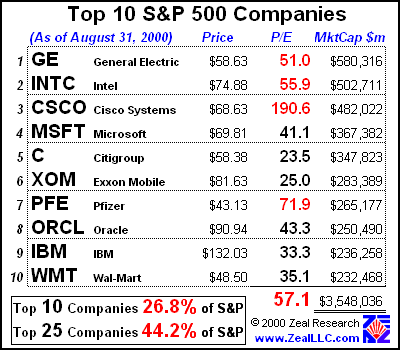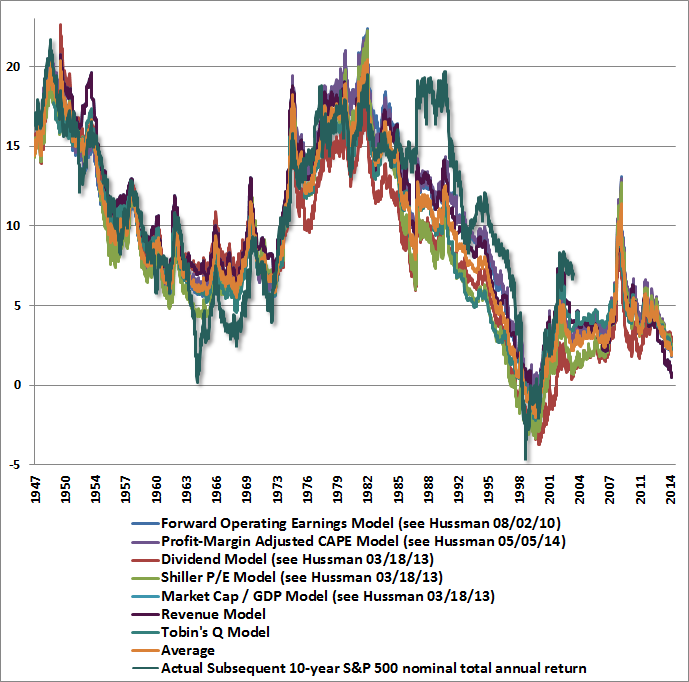Based on Real Math the S&P 500 Is Fairly Valued
Post on: 14 Июль, 2015 No Comment

- Page Title:
- Page URL:
This page has been successfully added into your Bookmark.
141 followers
Follow
As investors, we do not believe in forecasting stock markets or stock prices on individual stocks. Instead, we approach investing as the process of calculating intrinsic value based on fundamentals. To us, the most important fundamental to be considered when evaluating the True Worth™ of a market or a common stock is earnings. Therefore, it’s important that the reader understands that this article is offered as a mathematical calculation of what the S&P 500 is actually worth based on earnings. The reason we believe this to be important is because we also believe that any deviations from fair value will ultimately self-correct.
As we will soon illustrate, in the short run the stock market has a penchant for grossly mispricing common stocks and broad indices. When this is occurring, it is extremely valuable and important for investors to be able to recognize extreme and/or erroneous valuations when they manifest. It is also our contention that the calculation of fair valuation is both practical and achievable. In contrast, we further believe that attempting to forecast short-term market or price movements to be an exercise in futility. When irrational behavior is rampant, there is no logic that can be applied.
Our point is, making investment decisions based on valuation is a sound exercise that will bear fruit long term. As already stated, in the shorter run prices can go beyond fair value or below it. But, inevitably stock prices will seek intrinsic values. Therefore, we believe that intrinsic value is something that can be trusted, whereas stock price volatility cannot. Admittedly, this is not as easy as we may be making it appear. The trick lies in forecasting future earnings as accurately as possible. The better you can do that, the more accurate your long-term forecast will be. But, once again, we contend that forecasting earnings can be done more accurately than attempting to forecast short-term price movement. On the other hand, this is easier to do on an individual company (business), than it is on a broad index like the S&P 500.
Historically Normal Valuations
When writing articles such as this, many authors tend to gravitate towards statistical references. And, although there can be value found through statistical analysis, it’s also very easy to draw erroneous conclusions. With that said, there is a preponderance of historical data, and calculations based on that data, that the historical normal PE ratio for the S&P 500 is 15. However, even more importantly, we believe that there is a rational mathematical explanation for why a PE of 15 represents the proper average valuation for most companies and therefore, an index like the S&P 500.
A detailed explanation of the mathematical validity of the PE-equals-15 thesis is beyond the scope of this article. However, a brief explanation of the underlying principles should suffice. The normal PE of 15 is based on the reality that a stream of income generated from an investment is worth more than one times earnings. This is true even if the future income stream does not grow. In other words, if we assume, for example, an interest rate of 8.5% on a bond (of course bond yields are much lower than that today), we would discover that the bond is trading at approximately 12 times interest. Since the future income stream on a bond is fixed, it only stands to reason that a growing income stream, such as found on a stock, should also command a multiple greater than one, adjusted for risk.
That number has historically hovered around a PE of 15, because this represents an earnings yield of 6%-7%. This number is very close to the long-term historical returns that stocks have delivered on average. Admittedly, we have not provided significant proof of our statement based on what is written above. Instead, we are simply offering some hints as to how the normal PE of 15 can be justified. Put another way, there is a lot of research that suggests that the normal PE ratio for the S&P 500 over the past 100-plus years is 15. Additionally, there is further research that indicates that the normal PE ratio for the S&P 500 over the past 20 years has been closer to 20 (19.3 on our graph below). Our analysis, and a quick glance at the earnings- and price-correlated graph below, indicates that this higher-than-normal PE over the past 20 years can be mostly attributed to excessive overvaluation.
The S&P 500 via F.A.S.T. Graphs™
When looked at through the lens of our F.A.S.T. Graphs™ research tool, we can test theory and see how it applies in the real world. The following earnings and price correlated graph of the S&P 500 since calendar year 1994 tells some interesting stories. Perhaps the most interesting story is how the chart depicts two calculated PE ratios that equal the 20-year historical normal PE of approximately 20 (19.3), and the longer-term normal PE ratio of 15. In the first case, the PE of 20 (blue line with asterisks) was determined as the computer calculated the trimmed mean (outlier highs and lows trimmed to eliminate skewing) PE ratio for that time period. In the second case, the PE of 15 was determined by applying a widely accepted formula for valuing businesses to the EPS growth rate of 7.5% for the S&P 500 since 1994.

The important takeaway from reviewing the earnings- and price-correlated graph is the visual depiction of how statistics can mislead. Clearly, the black monthly closing stock price line often deviated significantly above and below the trimmed mean PE ratio of 20. Therefore, even though it is statistically accurate to state that the normal PE over this time frame was 20, a quick visual shows how often that was not true. As previously stated, we believe that the graph vividly illustrates the meaning of the phrase “irrational exuberance.
On the other hand, we believe the graph further vividly illustrates how the black monthly closing stock price line continuously attempted a reversion to the mean towards a historically significant normal PE of 15. The reader should note that although all data is plotted, when we draw a graph of 20 years, we only type in every other year’s data because of space restraints (note the asterisks by the years at the top of the graph).
In conclusion, there continues to be a lot of opinion and speculation regarding whether the S&P, or the stock market or stock prices in general are overvalued or not. From the perspective of earnings justified valuations as depicted in the graph above, at 14.1 times earnings, it is arguable that the S&P is slightly undervalued at these levels. Moreover, taken directly from its website, the current forecast for operating earnings of the S&P 500 by Standard & Poor’s Corp. is $101.33. If this forecast is accurate, it would imply a year-end fair value for the S&P of approximately 1519.40.
Mathematically, it would indicate that the S&P has approximately another 7.52% upside by year-end. Once again, this is not a prediction, but a mathematical calculation based on applying a normal PE ratio of 15 to the current earnings expectations of the S&P. It is our intention to provide an updated F.A.S.T. Graphs™ on the S&P periodically. If forecasts change, so will the anticipated valuation expectations.
Disclosure: I have no positions in any stocks mentioned and no plans to initiate any positions within the next 72 hours.
Disclaimer: The opinions in this document are for informational and educational purposes only and should not be construed as a recommendation to buy or sell the stocks mentioned or to solicit transactions or clients. Past performance of the companies discussed may not continue and the companies may not achieve the earnings growth as predicted. The information in this document is believed to be accurate, but under no circumstances should a person act upon the information contained within. We do not recommend that anyone act upon any investment information without first consulting an investment adviser as to the suitability of such investments for his specific situation.
About the author:
Chuck Carnevale
Charles (Chuck) C. Carnevale is the creator of F.A.S.T. Graphs™. Chuck is also co-founder of an investment management firm. He has been working in the securities industry since 1970: he has been a partner with a private NYSE member firm, the President of a NASD firm, Vice President and Regional Marketing Director for a major AMEX listed company, and an Associate Vice President and Investment Consulting Services Coordinator for a major NYSE member firm.
Prior to forming his own investment firm, he was a partner in a 30-year-old established registered investment advisory in Tampa, Florida. Chuck holds a Bachelor of Science in Economics and Finance from the University of Tampa. Chuck is a sought-after public speaker who is very passionate about spreading the critical message of prudence in money management. Chuck is a Veteran of the Vietnam War and was awarded both the Bronze Star and the Vietnam Honor Medal.














